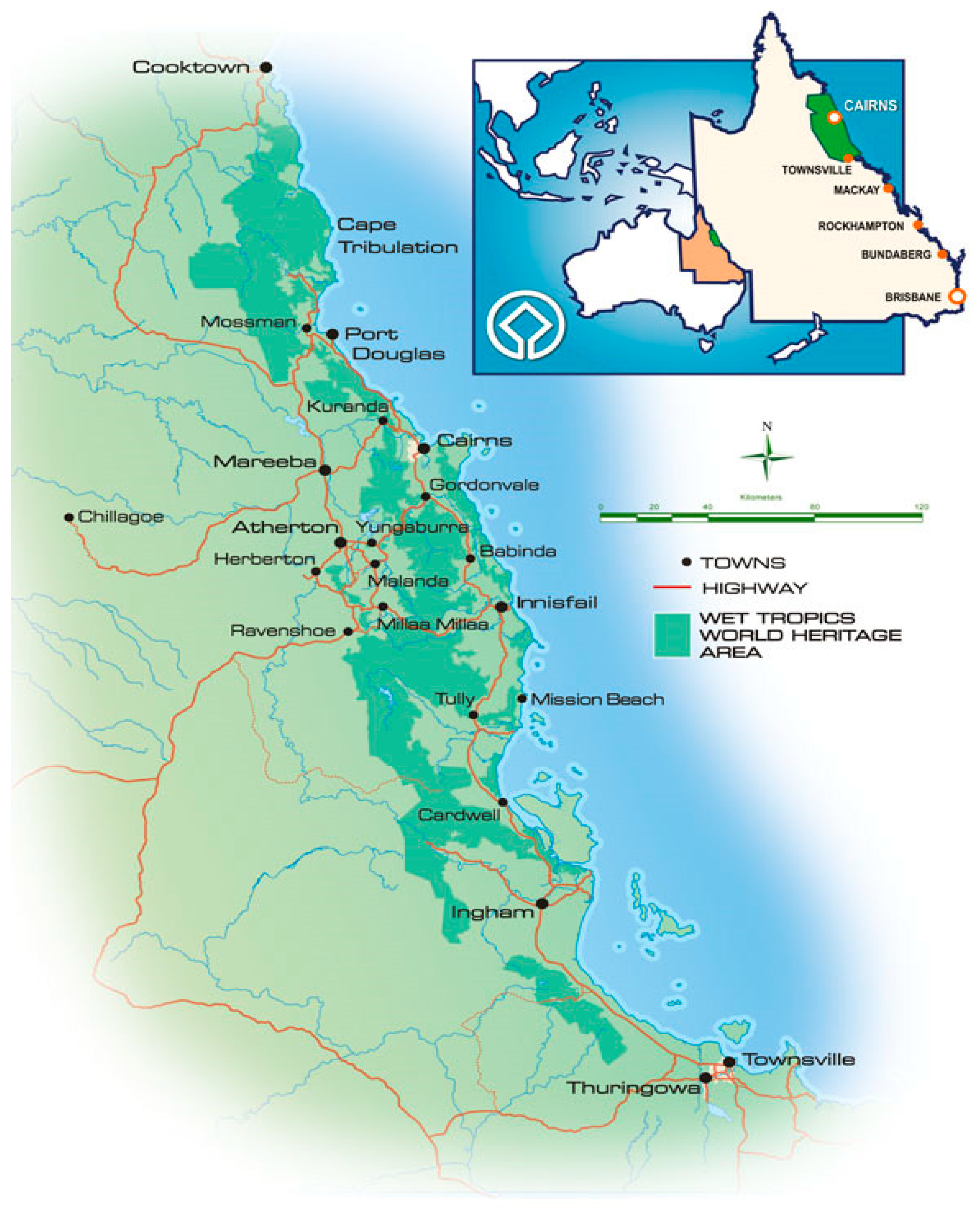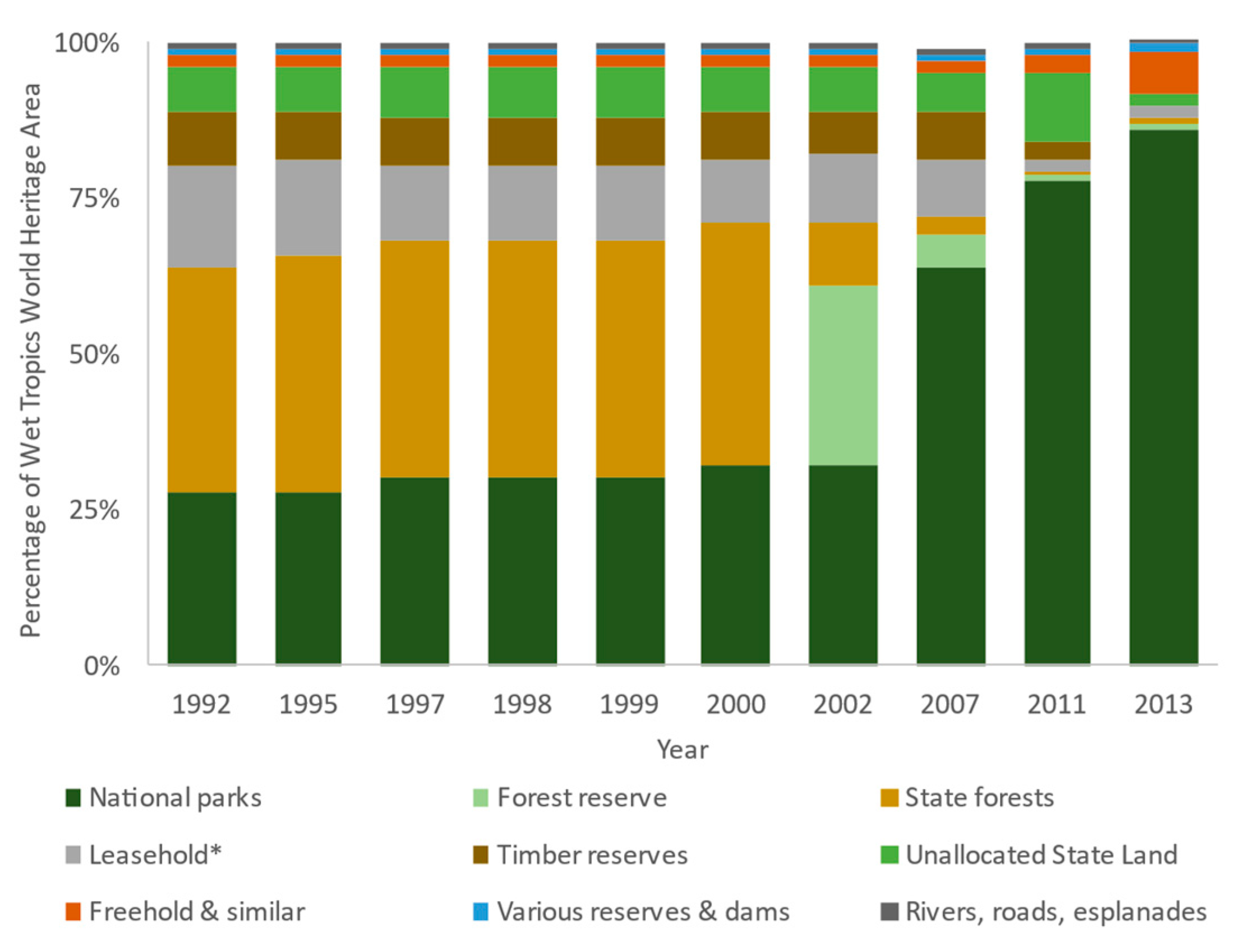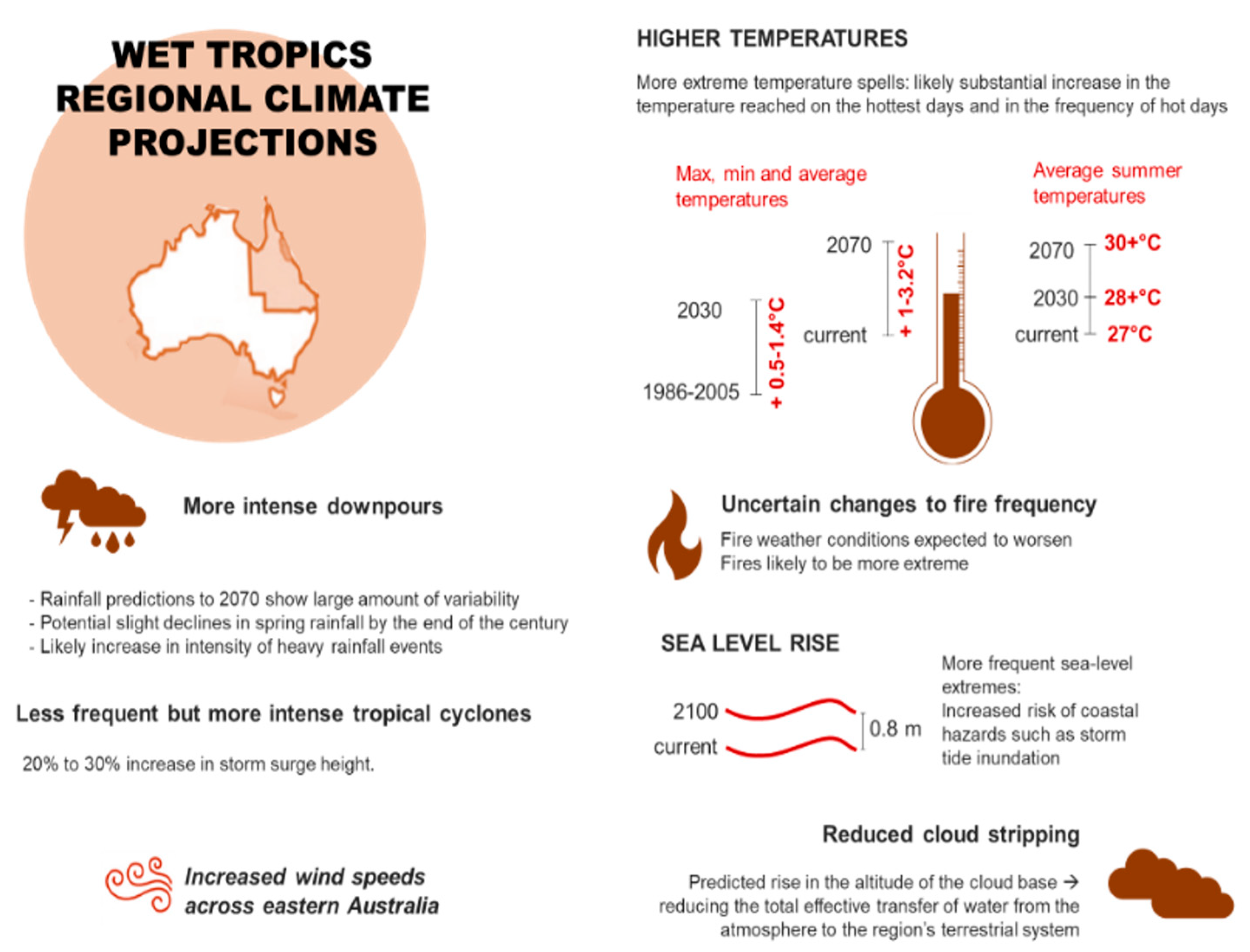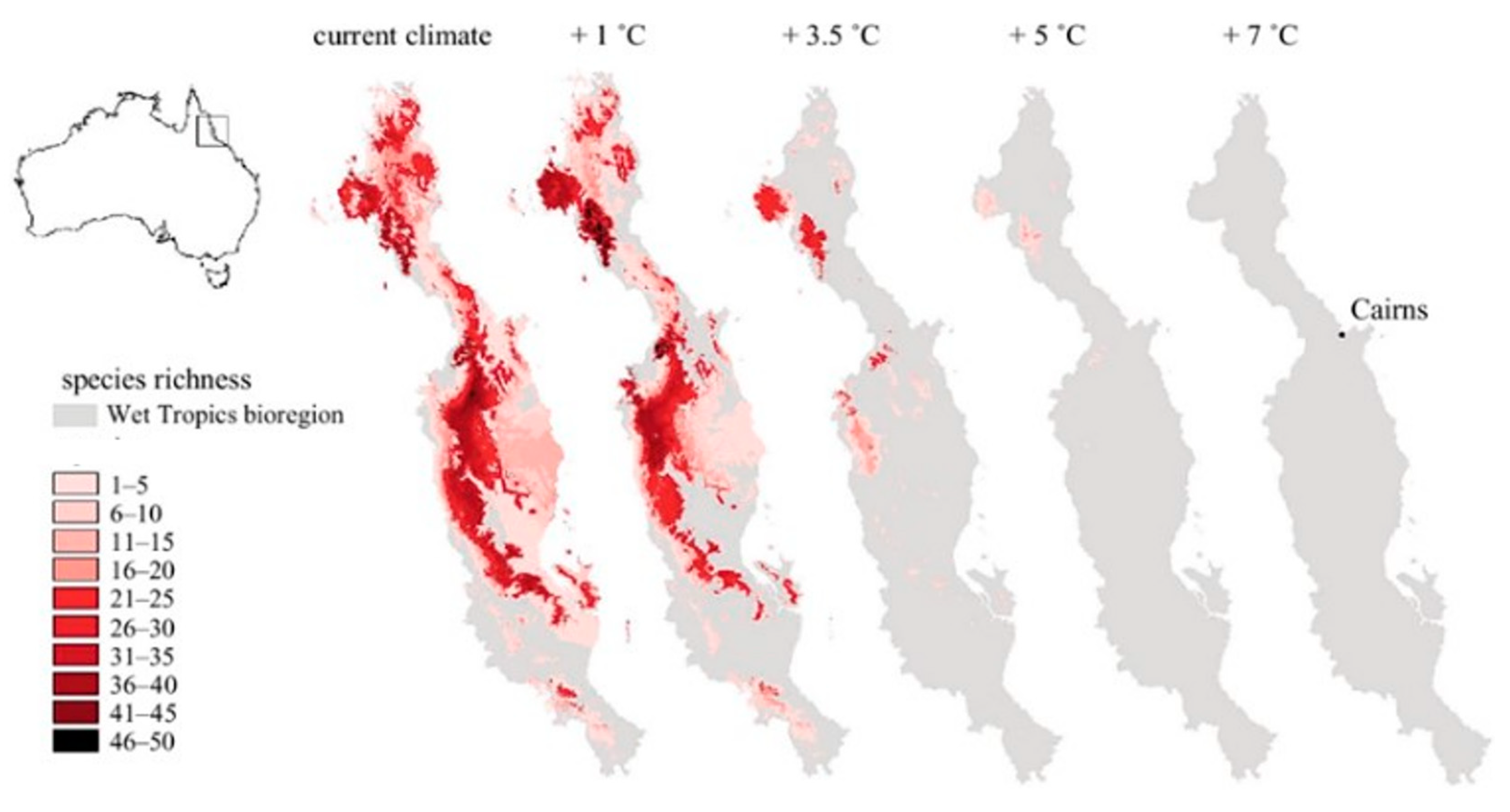Managing a World Heritage Site in the Face of Climate Change: A Case Study of the Wet Tropics in Northern Queensland
Abstract
1. Introduction
2. A Gem of Regulation and Protection
- natural phenomena or beauty;
- major stages of Earth’s history;
- significant ecological and biological processes;
- significant natural habitat for biodiversity.
3. The History and Legislation
4. Evidence of Investment in Protection and Management
5. Seeing the Signals and Predicting Their Impacts of Climate Change
5.1. Weather
Wet Tropics Regional Climate Projections
- Air temperature change (higher minimum and maximum temperatures and more frequent hot days)
- Change in wind–stronger trade winds
- Hydrology and occult precipitation (cloud stripping)
- Drought frequency and severity
- Humidity changes (higher evaporation)
- Rainfall changes and variability (more extreme rainfall events, uncertainty around the models)
- Tropical cyclone intensity and frequency (fewer but more intense)
- Water temperature increase and increased acidity
- Storm surge
- Sea level change
- Abiotic factors–e.g., fire weather (frequency, intensity, intervals)
- Increased carbon dioxide concentrations
5.2. Flora and Fauna
5.2.1. Abundance and Distribution of Key Species
5.2.2. Upland Flora
5.2.3. Upland Vertebrate Fauna
5.2.4. Invasive Species
5.3. Abiotic
5.3.1. Fire
5.3.2. Waterways and Rivers
5.3.3. Cloud Stripping and Consequences for Water Supply
5.4. Wider Climate Impacts: Cultural and Economic
5.4.1. Cultural
5.4.2. Tourism, Agriculture, and Horticulture
- reduced access due to flooding and high sea levels;
- deteriorating aesthetic value;
- reduced visitor comfort with rising temperatures and unpredictable weather patterns;
- increased perceived risk of visiting destination due to extreme weather events [55].
6. Responding to the Signals
6.1. Developing the Advocacy
6.2. Developing the Climate Adaptation Plan
- Establishing inclusive regional adaptation planning frameworks.
- Improving landscape resilience.
- Facilitating transition to adaptive communities and industries.
6.3. Establish Inclusive Regional Adaptation Planning Frameworks
6.4. Improve Landscape Resilience
6.4.1. Broadening the Engagement with the Community
6.4.2. Facilitate Transition to Adaptive Communities and Industries
6.5. Innovating to Tackle Climate Change in the Wet Tropics
6.5.1. Rainforest Refugia
6.5.2. Innovative Approaches
6.5.3. Increased Monitoring
6.5.4. Community Collaboration
7. Relevance for Other World Heritage Sites
8. Conclusions
- Many species, especially cool-adapted mountaintop endemics, will be displaced.
- Some ecosystems of the Wet Tropics will disappear entirely.
- Rainforest Aboriginal Peoples will lose the bio-cultural and natural character of their landscapes and related cultural heritage sites.
- The local community may suffer from a decline in revenue adversely affecting the local economy, jobs, and social wellbeing. Over 50 upland species could become globally extinct from the Wet Tropics World Heritage Area with only a moderate average temperature increase.
- Invasive species will increasingly impact native species with no natural defences.
- Bushfire risk will increase, forcing changes to fire management regimes.
Author Contributions
Funding
Data Availability Statement
Acknowledgments
Conflicts of Interest
Appendix A
| Frogs | |
| Cophixalus concinnus | Thornton Peak nurseryfrog |
| Pseudophryne covacevichae | Magnificent broodfrog |
| Cophixalus hosmeri | Rattling nurseryfrog |
| Mixophyes carbinensis | Carbine barred frog |
| Cophixalus neglectus | Bellenden Ker nurseryfrog |
| Cophixalus exiguous | Daintree nursery frog |
| Cophixalus monticola | Mountain nursery frog |
| Taudactylus rheophilus | Northern tinker frog |
| Mammals | |
| Antechinus godmani | Atherton antechinus |
| Hemibelideus lemuroides | Lemuroid ringtail possum |
| Petaurus gracilis | Mahogany glider |
| Pseudochirulus cinereus | Daintree River ringtail possum |
| Pseudochirulus herbertensis | Herbert River ringtail possum |
| Dasyurus maculatus gracilis | Spotted-tailed quoll (northern sub-species) |
| Birds | |
| Acanthiza katherina | Mountain thornbill |
| Alisterus scapularis minor | Wet Tropics Australian King-Parrot |
| Colluricincla boweri | Bower’s Shrike-thrush |
| Cormobates leucophaea minor | Little Treecreeper |
| Gerygone mouki mouki | Wet Tropics Brown Gerygone |
| Heteromyias cinereifrons | Grey-headed Robin |
| Lophorina victoriae | Victoria’s Riflebird |
| Oreoscopus gutturalis | Fernwren |
| Prionodura newtoniana | Golden bowerbird |
| Psophodes olivaceus lateralis | Wet Tropics Eastern Whipbird |
| Scenopoeetes dentirostris | Tooth-billed Bowerbird |
| Sericornis keri | Atherton scrubwren |
| Sericornis magnirostra viridior | Wet Tropics Large-billed Scrubwren |
| Skinks | |
| Calyptotis thorntonensis | Thornton Peak skink |
| Techmarscincus jigurru | Bartle Frere cool- skink |
| Saproscincus czechurai | wedge-snouted shade skink |
| Saproscincus lewisi | Cooktown shade skink |
| Lampropholis robertsi | Grey-bellied sun skink |
| Eulamprus frerei | Bartle Frere bar-sided skink |
| Glaphyromorphus mjobergi | Atherton Tableland mulch-skink |
| Flowering plants | |
| Acrotriche baileyana | |
| Austromuellera valida | |
| Bulbophyllum lilianae | Warty strand orchid |
| Cinnamomum propinquum | Pepperwood |
| Dracophyllum sayeri | |
| Elaeocarpus hylobroma | Quandong |
| Elaeocarpus linsmithii | Quandong |
| Flindersia oppositifolia | Mountain silkwood |
| Garcinia brassii | Mountain mangosteen |
| Gynochthodes constipate | |
| Gynochthodes podistra | |
| Leptospermum wooroonooran | Wurunuru ti-tree, mountain teatree |
| Leucopogon malayanus subsp. novoguineensis | |
| Litsea granitica | Bollywood |
| Octarrhena pusilla | Wispy grub orchid |
| Parsonsia bartlensis | |
| Pleioluma singuliflora | Lewis coondoo |
| Polyscias bellendenkerensis | |
| Symplocos wooroonooran | Small-leaved hazelwood |
| Syzygium fratris | |
| Tasmannia sp. (Mt Bellenden Ker J.R.Clarkson 6571) | |
| Trachymene geraniifolia | Geranium-leaved Trachymene |
| Zieria madida | |
| Conifers | |
| Agathis atropurpurea | Black kauri or purple kauri |
| Ferns | |
| Hymenophyllum whitei | filmy fern |
References
- Reimann, L.; Vafeidis, A.T.; Brown, S.; Hinkel, J.; Tol, R.S.J. Mediterranean UNESCO World Heritage at risk from coastal flooding and erosion due to sea-level rise. Nat. Commun. 2018, 9, 4161. [Google Scholar] [CrossRef] [PubMed]
- Hughes, T.P.; Kerry, J.T.; Álvarez-Noriega, M.; Álvarez-Romero, J.G.; Anderson, K.D.; Baird, A.H.; Babcock, R.C.; Beger, M.; Bellwood, D.R.; Berkelmans, R.; et al. Global warming and recurrent mass bleaching of corals. Nature 2017, 543, 373–377. [Google Scholar] [CrossRef]
- United Nations Educational, Scientific and Cultural Organization (UNESCO). World Heritage List—Wet Tropics of Queensland. 1988. Available online: https://whc.unesco.org/en/list/486/ (accessed on 23 February 2021).
- Hill, R.; Baird, A. Kuku-Yalanji rainforest aboriginal people and carbohydrate resource management in the wet tropics of Queensland, Australia. Hum. Ecol. 2003, 31, 27–52. [Google Scholar] [CrossRef]
- Australian Government Department of Agriculture, Water and the Environment. Place Details, Wet Tropics of Queensland. Available online: http://www.environment.gov.au/cgi-bin/ahdb/search.pl?mode=place_detail;place_id=105689 (accessed on 1 January 2021).
- Osipova, E.; Emslie-Smith, M.; Osti, M.; Murai, M.; Åberg, U.; Shadie, P. IUCN World Heritage Outlook 3: A Conservation Assessment of All Natural World Heritage Sites, November 2020. Gland, Switzerland: IUCN. x + 90 pp. Available online: https://doi.org/10.2305/IUCN.CH.2020.16.en (accessed on 1 January 2021).
- Queensland Government. Wet Tropics World Heritage Protection and Management Act 1993 QLD. Available online: https://www.legislation.qld.gov.au/view/html/inforce/current/act-1993-050 (accessed on 1 January 2021).
- Wet Tropics Management Authority. Wet Tropics of Queensland World Heritage Area Regional Agreement. Cairns. 2005. Available online: https://www.wettropics.gov.au/site/user-assets/regional_agreement.pdf (accessed on 1 January 2021).
- International Union for the Conservation of Nature (IUCN). IUCN World Heritage Outlook. 2020. Available online: https://portals.iucn.org/library/node/49134 (accessed on 1 January 2021).
- Shukla, P.R.; Skea, J.; Calvo Buendia, E.; Masson-Delmotte, V.; Pörtner, H.-O.; Roberts, D.C.; Zhai, P.; Slade, R.; Connors, S.; van Diemen, R.; et al. (Eds.) Technical Summary. In Climate change and Land: An IPCC Special Report on Climate Change, Desertification, Land Degradation, Sustainable Land Management, Food Security, and Greenhouse Gas Fluxes in Terrestrial Ecosystems; The Intergovernmental Panel on Climate Change (IPCC): Genève, Switzerland, 2019; in press. [Google Scholar]
- Suppiah, R.; Macadam, I.; Whetton, P.H. Climate Change Projections for the Tropical Rainforest Region of North Queensland; Unpublished Report to the Marine and Tropical Sciences Research Facility; Reef and Rainforest Research Centre Limited: Cairns, Australia, 2007; 38p. [Google Scholar]
- Chand, S.S. Climate change scenarios and projections for the Pacific. In Climate Change and Impacts; Springer: Cham, Switzerland, 2020; pp. 171–199. [Google Scholar]
- Queensland Government. Climate change in the Far North Queensland Region. Department of Environment and Science. 2019. Available online: www.qld.gov.au/__data/assets/pdf_file/0025/68371/far-north-qld-climate-change-impact-summary.pdf (accessed on 25 February 2021).
- Williams, S.E.; Hilbert, D.W. Climate change as a threat to the biodiversity of tropical rainforests in Australia. In Emerging Threats to Tropical Forests; Laurance, W.F., Peres, C.A., Eds.; University of Chicago Press: Chicago, IL, USA, 2006; pp. 33–52. [Google Scholar]
- Wet Tropics Management Authority. 2015–2016 State of the Wet Tropics Report: Ancient, Endemic, Rare and Threatened Vertebrates of the Wet Tropics; Wet Tropics Management Authority: Cairns, Australia, 2016.
- Invasive Species Council. Invasive Species and Climate Change. 2009. Available online: www.invasives.org.au/wp-content/uploads/2014/02/fs_animalsandclimatechange.pdf (accessed on 1 January 2021).
- Warren, R.; VanDerWal, J.; Price, J.; Welbergen, J.A.; Atkinson, I.; Ramirez-Villegas, J.; Osborn, T.J.; Jarvis, A.; Shoo, L.P.; Williams, S.E.; et al. Quantifying the benefit of early climate change mitigation in avoiding biodiversity loss. Nat. Clim. Chang. 2013, 3, 678–682. [Google Scholar] [CrossRef]
- Meade, J.; VanDerWal, J.; Storlie, C.; Williams, S.; Gourret, A.; Krockenberger, A.; Welbergen, J. Substantial reduction in thermo-suitable microhabitat for a rainforest marsupial under climate change. Biol. Lett. 2018, 14, 12. [Google Scholar] [CrossRef]
- Roeble, E. Modelling the Vulnerability of Endemic Montane Flora to Climate Change in the Australian Wet Tropics. Master’s Thesis, Imperial College London, London, UK, 2018. [Google Scholar]
- Shoo, L.P.; Storlie, C.; Williams, Y.M.; Williams, S.E. Potential for mountaintop boulder fields to buffer species against extreme heat stress under climate change. Int. J. Biometeorol. 2010, 54, 475–478. [Google Scholar] [CrossRef]
- Williams and Lam. (Unpublished data).
- Williams, S.E.; de la Fuente, A. Long-term changes in populations of rainforest birds in the Australian Wet Tropics bioregion: A climate/biodiversity emergency. Proc. Roy. Soc. Lond. B 2021. Available online: https://usern.tums.ac.ir/User/CV/Stephen_Williams (accessed on 1 January 2021).
- Garnett, S.T.; Baker, G.B. Action Plan for Australian Birds 2020; CSIRO: Melbourne, Australia, 2020; in press. [Google Scholar]
- Garnett, S.T.; Franklin, D.C.; Ehmke, G.; VanDerWal, J.J.; Hodgson, L.; Pavey, C.; Reside, A.E.; Welbergen, J.A.; Butchart, S.H.M.; Perkins, G.C.; et al. Climate Change Adaptation Strategies for Australian Birds; National Climate Change Adaptation Research Facility: Gold Coast, Australia, 2013; 925p. [Google Scholar]
- Williams, S.E.; Bolitho, E.E.; Fox, S. Climate change in Australian tropical rainforests: An impending environmental catastrophe. Proc. R. Soc. B Boil. Sci. 2003, 270, 1887–1892. [Google Scholar] [CrossRef] [PubMed]
- Williams, S.E.; Falconi, L. Climate Change Could Empty Wildlife from Australia’s Rainforests. In The Conversation. 2015. Available online: https://theconversation.com/climate-change-could-empty-wildlife-from-australias-rainforests-41023 (accessed on 1 January 2021).
- Kaiser, B.A. Economic impacts of non-indigenous species: Miconia and the Hawaiian economy. Euphytica 2006, 148, 135–150. [Google Scholar] [CrossRef]
- Brooks, S.; Logan, P. Management of Chromolaena odorata in the Douglas Shire. In Proceedings of the 21st Australasian Weeds Conference, “Weed Biosecurity-Protecting our Future”, Sydney, Australia, 9–13 September 2018; pp. 345–349. [Google Scholar]
- Moran, C.; Boulter, S. Biodiversity and Ecosystems Climate Adaptation Plan. Brisbane, Australia. 2018; 89p. Available online: https://www.qld.gov.au/__data/assets/pdf_file/0022/87610/b-e-cap.pdf (accessed on 1 January 2021).
- Dowdy, A.J. Climatological Variability of fire weather in Australia. J. Appl. Meteorol. Climatol. 2018, 57, 221–234. [Google Scholar] [CrossRef]
- Dunlop, M.; Hilbert, D.W.; Stafford-Smith, M.; Davies, R.; James, C.D.; Ferrier, S.; House, A.; Liedloff, A.; Prober, S.M.; Smyth, A.; et al. Implications for Policymakers: Climate Change, Biodiversity Conservation and the National Reserve System; CSIRO Climate Adaptation Flagship: Canberra, Australia, 2012. [Google Scholar]
- Medeiros, A.C.; Loope, L.L.; Conant, P.; McElvaney, S. Status, ecology, and management of the invasive plant, Miconia calvescens DC (Melastomataceae) in the Hawaiian Islands. Brit. Mus. Occas. Pap. 1997, 48, 23–36. [Google Scholar]
- Hilbert, D.W.; Hill, R.; Moran, C.; Turton, S.M.; Bohnet, I.; Marshall, N.A.; Pert, P.L.; Stoeckl, N.; Murphy, H.T.; Reside, A.E.; et al. Climate Change Issues and Impacts in the Wet Tropics NRM Cluster Region; James Cook University: Cairns, Australia, 2014. [Google Scholar]
- Loope, L.L.; Krushelnycky, P.D. Current and potential ant impacts in the Pacific region. Proc. Hawaii Entomol. Soc. 2007, 39, 69–73. [Google Scholar]
- Lach, L. James Cook University TESS Seminar Held 11 March 2020. Available online: https://mediasite.jcu.edu.au/Mediasite/Play/eb263da1e3594ab098b72696ec146d551d (accessed on 1 January 2021).
- Doyle, K. 2019 Was Australia’s Hottest Year on Record. Australian Broadcasting Commission. Published 2 January 2020. Available online: www.abc.net.au/news/2020-01-02/2019-was-australias-hottest-and-driest-year-on-record/11837312 (accessed on 1 January 2021).
- Wet Tropics Management Authority. State of Wet Tropics 2019–2020: Creating Our Climate Future; Wet Tropics Management Authority: Cairns, Australia, 2020.
- Wet Tropics Management Authority. State of Wet Tropics Report 2014/15: Economic Value of the Wet Tropics World Heritage Area; Wet Tropics Management Authority: Cairns, Australia, 2015.
- Esparon, M.; Farr, M.; Larson, S.; Stoeckl, N. Social values and growth and their implications for ecosystem services in the long-run. Australas. J. Reg. Stud. 2018, 24, 327–346. [Google Scholar]
- McJannet, D.; Reddell, P. Where earth meets sky: Cloud forests of the Wet Tropics. In Using Rainforest Research; Cooperative Research Centre for Tropical Rainforest Ecology and Management: Cairns, Australia, 2002. [Google Scholar]
- Narsey, S.; Laidlaw, M.; Colman, R.; Pearce, K.; Hopkins, M.; Dowdy, A. Impact of Climate Change on Cloud Forests in the Gondwana Rainforests of Australia World Heritage Area; Earth Systems and Climate Change Hub Report No. 20; NESP Earth Systems and Climate Change Hub: Australia, 2020; Available online: https://nespclimate.com.au/wp-content/uploads/2020/09/Gondwana-LCL-CS-TR-final.pdf (accessed on 1 January 2021).
- Georgious, A. Climate Change is Stripping the Magnificent Cloud Forests of Their Clouds; Newsweek, Tech & Science. 2019. Available online: https://www.newsweek.com/climate-change-cloud-forests-1399098 (accessed on 1 January 2021).
- McJannet, D.; Wallace, J.; Reddell, P. Precipitation interception in Australian tropical rainforests: II. Altitudinal gradients of cloud interception, stemflow, throughfall and interception. Hydrol. Process. 2007, 211, 703–718. [Google Scholar] [CrossRef]
- Cheney, A. Ecosystem Services in the Wet Tropics: A Literature Review and Economic Valuation. Independent Study Project (ISP) Collection # 1947. 2014. Available online: https://digitalcollections.sit.edu/isp_collection/1947 (accessed on 1 January 2021).
- Gillespie Economics. Economic Activity of Australia’s World Heritage Areas; Report to the Department of the Environment, Water, Heritage and the Arts; 2008. Available online: https://www.wettropics.gov.au/site/user-assets/docs/gilespie-economic-activity-report.pdf (accessed on 1 January 2021).
- Low-Choy, D.; Clarke, P.; Jones, D.; Serrao-Neumann, S.; Hales, R.; Koschade, O. Understanding Coastal Urban and Peri-Urban Indigenous People’s Vulnerability and Adaptive Capacity to Climate Change; National Climate Change Adaptation Research Facility: Gold Coast, Australia, 2013. [Google Scholar]
- Veland, S.; Howitt, R.; Dominey-Howes, D.; Thomalla, F.; Houston, D. Procedural vulnerability: Understanding environmental change in a remote indigenous community. Glob. Environ. Chang. 2013, 23, 314–326. [Google Scholar] [CrossRef]
- Nursey-Bray, M.; Palmer, R.; Smith, T.F.; Rist, P. Old ways for new days: Australian Indigenous peoples and climate change. Int. J. Justice Sustain. 2019, 24, 473–486. [Google Scholar] [CrossRef]
- Stokes, C.J.; Howden, S.M. Adapting Agriculture to Climate Change: Preparing Australian Agriculture, Forestry and Fisheries for the Future; CSIRO Publishing: Canberra, Australia, 2010. [Google Scholar]
- Gooch, M.; Vella, K.; Marshall, N.A.; Tobin, R.C.; Pears, R. A rapid assessment of the effects of extreme weather on two Great Barrier Reef Industries. Aust. Plan. 2012, 50, 198–215. [Google Scholar] [CrossRef]
- Wet Tropics Management Authority. Wet Tropics Nature Based Tourism Strategy: A Strategy for the Development and Management of Nature-Based Tourism; Wet Tropics Management Authority: Cairns, Australia, 2000.
- Esparon, M.; Stoeckl, N.; Larson, S.; Farr, M.; Schmider, J.; Bellafquih, R.; Levers, S. How ‘valuable’are the ecosystem services of the Wet Tropics World Heritage Area to residents and tourists. In Report to the National Environmental Research Program; Reef and Rainforest Research Centre Limited: Cairns, Australia, 2014. [Google Scholar]
- Driml, S. Travel Cost Analysis of Recreation Value in the Wet Tropics World Heritage Area. Econ. Anal. Policy 2002, 32, 11–26. [Google Scholar] [CrossRef]
- Prideaux, B.; Falco-Mammone, F. Economic Values of Tourism in the Wet Tropics World Heritage Area. Cooperative Research Centre for Tropical Rainforest Ecology and Management; James Cook University: Cairns, Australia, 2007. [Google Scholar]
- Tourism Tropical North Queensland. Tropical North Queensland Destination Tourism Plan 2021; TTNQ: Cairns, Australia, 2020. [Google Scholar]
- Hoogendoorn, G.; Fitchett, J.M. Tourism and climate change: A review of threats and adaptation strategies for Africa. Curr. Issues Tour. 2016, 21, 742–759. [Google Scholar] [CrossRef]
- Wet Tropics Management Authority. A Statement from the Board of the Wet Tropics Management Authority Regarding Serious Climate Change Impacts on the Wet Tropics of Queensland World Heritage Area. 2019. Available online: https://www.wettropics.gov.au/site/user-assets/docs/2019.04.29%20WTMA%20board%20climate%20change%20statement.pdf (accessed on 1 January 2021).
- Queensland Government. First Nations Climate Summit Statements. 2019. Available online: qld.gov.au/statements/87511 (accessed on 1 January 2021).
- Wet Tropics Management Authority. Climate Adaptation Plan for the Wet Tropics 2020–2030. Accept, Act Adapt; Wet Tropics Management Authority: Cairns, Australia, 2019.
- Paul, K.I.; Cunningham, S.C.; England, J.R.; Roxburgh, S.H.; Preece, N.D.; Lewis, T.; Brooksbank, K.; Crawford, D.F.; Polglase, P.J. Managing reforestation to sequester carbon, increase biodiversity potential and minimize loss of agricultural land. Land Use Policy 2016, 51, 135–149. [Google Scholar] [CrossRef]
- Derhé, M.A.; Murphy, H.; Monteith, G.; Menéndez, R. Measuring the success of reforestation for restoring biodiversity and ecosystem functioning. J. Appl. Ecol. 2016, 53, 1714–1724. [Google Scholar] [CrossRef]
- Shoo, L.P.; Storlie, C.; Vanderwal, J.; Little, J.; Williams, S.E. Targeted protection and restoration to conserve tropical biodiversity in a warming world. Glob. Chang. Biol. 2011, 17, 186–193. [Google Scholar] [CrossRef]
- Bermingham, E.; Dick, C.W.; CMoritz, C. Tropical Rainforests: Past, Present, and Future; University of Chicago Press: Chicago, IL, USA, 2005. [Google Scholar]
- Metcalfe, D.J.; Ford, A.J. Floristics and plant biodiversity of the rainforests of the Wet Tropics. In Living in a Dynamic Tropical Forest Landscape; Stork, N.E., Turton, S.M., Eds.; Blackwell Publishing: Hoboken, NJ, USA, 2008. [Google Scholar]
- Braverman, I. Captive for Life: Conserving extinct in the wild species through ex situ Breeding. In The Ethics of Captivity; Lori, G., Ed.; Oxford University Press: Oxford, UK, 2014; pp. 193–212. [Google Scholar]
- Taylor, G.; Canessa, S.; Clarke, R.H.; Ingwersen, D.; Armstrong, D.P.; Seddon, P.J.; Ewen, J.G. Is reintroduction biology an effective applied science? Trends Ecol. Evol. 2017, 32, 873–880. [Google Scholar] [CrossRef] [PubMed]
- Canessa, S.; Converse, S.J.; West, M.; Clemann, N.; Gillespie, G.; McFadden, M.; Silla, A.J.; Parris, K.M.; McCarthy, M.A. Planning for ex-situ conservation in the face of uncertainty. Conserv. Biol. 2015, 30, 599–609. [Google Scholar] [CrossRef] [PubMed]
- Schwartz, K.R.; Parsons, E.C.M.; Rockwood, L.; Wood, T.C. Integrating In-Situ and Ex-Situ Data Management Processes for Biodiversity Conservation. Front. Ecol. Evol. 2017, 5, 120. [Google Scholar] [CrossRef]
- Australian Tropical Herbarium (Unpublished Data) Extracted from Queensland Nature Conservation (Plants) Regulation. 2020. Available online: www.legislation.qld.gov.au/view/html/inforce/current/sl-2020-0137 (accessed on 1 January 2021).
- Field, J.H.; Kealhofer, L.; Cosgrove, R.; Coster, A.C. Human-environment dynamics during the Holocene in the Australian Wet Tropics of NE Queensland: A starch and phytolith study. J. Anthr. Archaeol. 2016, 44, 216–234. [Google Scholar] [CrossRef]
- Ainsworth, T.D.; Heron, S.F.; Ortiz, J.C.; Mumby, P.; Grech, A.; Ogawa, D.; Eakin, C.M.; Leggat, W. Climate change disables coral bleaching protection on the Great Barrier Reef. Sci. 2016, 352, 338–342. [Google Scholar] [CrossRef]
- Perry, J.; Falzon, C. Climate Change Adaptation for Natural World Heritage Sites: A Practical Guide; UNESCO: Paris, France, 2014; Volume 37. [Google Scholar]
- Phillips, H. Adaptation to Climate Change at UK World Heritage Sites: Progress and Challenges. Hist. Env. Policy Pr. 2014, 5, 288–299. [Google Scholar] [CrossRef]
- United Nations Educational, Scientific and Cultural Organisation (UNESCO). Convention Concerning the Protection of the World Cultural and Natural Heritage, Adopted by the General Conference at Its Seventeenth Session Paris; UNESCO: Paris, France, 1972; 17p. [Google Scholar]
- Elemide, O.A. Climate change mitigation through environmental intensification a case study of Sub–Sahara African. In ASABE 1st Climate Change Symposium: Adaptation and Mitigation Conference Proceedings; American Society of Agricultural and Biological Engineers: St. Joseph, MI, USA, 2015. [Google Scholar]
- Reef Restoration and Adaptation Program for the Great Barrier Reef. 2021. Available online: https://gbrrestoration.org/ (accessed on 1 January 2021).





| World Heritage Attribute that Contributes to the OUV of the Wet Tropics | WH Criteria | Climate Stressor Identified for the Wet Tropics | |||||||||||
|---|---|---|---|---|---|---|---|---|---|---|---|---|---|
| 1 | 2 | 3 | 4 | 5 | 6 | 7 | 8 | 9 | 10 | 11 | 12 | ||
| Scenic vistas where rugged forested landscapes meet intact coastal ecosystems | vii, viii | ✓ | ✓ | ✓ | |||||||||
| Rugged mountains peaks, escarpments and gorges | vii, viii | ✓ | ✓ | ✓ | |||||||||
| Rivers, natural waterbodies and waterfalls | vii | ✓ | ✓ | ✓ | ✓ | ✓ | |||||||
| Emotional, intellectual, material and/or spiritual sense of, and attachment to place | vii, viii, ix, x | ✓ | ✓ | ✓ | ✓ | ✓ | ✓ | ✓ | ✓ | ||||
| Intact record of the evolution of the major stages of plant life on earth | viii | ✓ | ✓ | ✓ | ✓ | ✓ | ✓ | ✓ | |||||
| Taxa that represent ancient lineages | viii, ix, x | ✓ | ✓ | ✓ | ✓ | ✓ | ✓ | ✓ | ✓ | ✓ | |||
| Endemic taxa | viii, ix, x | ✓ | ✓ | ✓ | ✓ | ✓ | ✓ | ✓ | ✓ | ✓ | |||
| High biodiversity | viii, ix, x | ✓ | ✓ | ✓ | ✓ | ✓ | ✓ | ✓ | ✓ | ✓ | ✓ | ✓ | ✓ |
| Threatened, endemic ecosystems | ix, x | ✓ | ✓ | ✓ | ✓ | ✓ | ✓ | ✓ | ✓ | ✓ | ✓ | ✓ | ✓ |
| Intact ecotones between rainforest and sclerophyll communities | ix, x | ✓ | ✓ | ✓ | ✓ | ✓ | ✓ | ✓ | |||||
| Ongoing ecological processes and biological evolution | ix, x | ✓ | ✓ | ✓ | ✓ | ✓ | ✓ | ✓ | ✓ | ✓ | ✓ | ✓ | ✓ |
| Climate refugia (past, present and future) | ix, x | ✓ | ✓ | ✓ | ✓ | ✓ | ✓ | ✓ | ✓ | ✓ | ✓ | ✓ | ✓ |
| Maintenance of the Environment | Utilitarian Uses | Personal Benefits | Ethics |
|---|---|---|---|
|
|
|
|
| Establish Inclusive Regional Adaptation Planning Frameworks | Improve Landscape Resilience | Facilitate Transition to Adaptive Communities and Industries |
|---|---|---|
|
|
|
Publisher’s Note: MDPI stays neutral with regard to jurisdictional claims in published maps and institutional affiliations. |
© 2021 by the authors. Licensee MDPI, Basel, Switzerland. This article is an open access article distributed under the terms and conditions of the Creative Commons Attribution (CC BY) license (https://creativecommons.org/licenses/by/4.0/).
Share and Cite
Weber, E.T.; Catterall, C.P.; Locke, J.; Ota, L.S.; Prideaux, B.; Shirreffs, L.; Talbot, L.; Gordon, I.J. Managing a World Heritage Site in the Face of Climate Change: A Case Study of the Wet Tropics in Northern Queensland. Earth 2021, 2, 248-271. https://doi.org/10.3390/earth2020015
Weber ET, Catterall CP, Locke J, Ota LS, Prideaux B, Shirreffs L, Talbot L, Gordon IJ. Managing a World Heritage Site in the Face of Climate Change: A Case Study of the Wet Tropics in Northern Queensland. Earth. 2021; 2(2):248-271. https://doi.org/10.3390/earth2020015
Chicago/Turabian StyleWeber, Ellen T., Carla P. Catterall, John Locke, Liz S. Ota, Bruce Prideaux, Leslie Shirreffs, Leah Talbot, and Iain J. Gordon. 2021. "Managing a World Heritage Site in the Face of Climate Change: A Case Study of the Wet Tropics in Northern Queensland" Earth 2, no. 2: 248-271. https://doi.org/10.3390/earth2020015
APA StyleWeber, E. T., Catterall, C. P., Locke, J., Ota, L. S., Prideaux, B., Shirreffs, L., Talbot, L., & Gordon, I. J. (2021). Managing a World Heritage Site in the Face of Climate Change: A Case Study of the Wet Tropics in Northern Queensland. Earth, 2(2), 248-271. https://doi.org/10.3390/earth2020015








